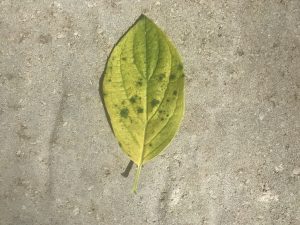Hydrangea Leaves Turning Yellow Fundamentals Explained
Top Guidelines Of Hydrangea Leaves Turning Yellow
Table of ContentsIndicators on Hydrangea Leaves Turning Yellow You Should KnowThe Buzz on Hydrangea Leaves Turning YellowExcitement About Hydrangea Leaves Turning YellowThe Single Strategy To Use For Hydrangea Leaves Turning YellowSome Known Details About Hydrangea Leaves Turning Yellow A Biased View of Hydrangea Leaves Turning Yellow
Sprinkling your plant with hard water triggers the plant's leaves to transform yellow, however the blood vessels will certainly stay eco-friendly. Nitrogen is a primal nutrient for plants.Those indications include stunted growth and the yellowing of lower, older leaves in the plant. We're right here to help you with that.
Iron-tone is all set to use and needs no mixing and will recover deep green shade to chlorotic yellow plants, FOR NATURAL GARDENING: Iron-tone is authorized for natural horticulture; It is a signed up Organic Input Material meaning it satisfies all demands for organic manufacturing, MADE IN THE USA: Product of the Espoma Business.
Over-watering and under-watering are both damaging to your plant. Make certain you stick with a watering regimen that'll suit your plant. Keep in mind to not allow the soil dry totally and water the plant once a week. To preserve moisture, mulching is advised. Mulching is adding undecomposed plant product to the soil.
Rumored Buzz on Hydrangea Leaves Turning Yellow
This is one of the most usual issues that new hydrangea garden enthusiasts and experienced veterans go through every period. There are a few, extremely common, aspects that can cause your hydrangea leaves to become blemished and brownish.
Before planting, water the plant. If you haven't done this and the plant is already in the ground this will certainly simply take a little bit of time and water.
Due to excessive fertilizing in summertime, a melt might appear on the fallen leaves. Hydrangeas do not need also much when it comes to fertilization.
You may see some brown sides on your fallen leaves. The fallen leaves might come to be crispy. This is fertilizer burn. The burn appears on the leaves, however that doesn't indicate that the fertilizer really reached the leaves. Hydrangea Leaves Turning Yellow. This type of burn normally originates from the roots, and that implies you can have zapped the origins too.
Hydrangea Leaves Turning Yellow Fundamentals Explained
If you have actually located these crunchy leaves on your plant, you can leave them. Or you can snip them off to help the appearance of your plant. One of the most typical insects are aphids, spider termites and beetles. Hydrangeas can have problems with typical yard pests such as. The feeding injuries of these insects can turn brownish and cause brown places to appear on the fallen leaves and stems of the plant.
Knock the beetles into a pail of soapy water, or utilize a strong spray from your tube to disrupt the aphids. You can additionally spray soapy water onto all of the plant's surface areas. In enhancement to these easy approaches, you can to help obtain rid of these pests. It is necessary to check out the application price info that can be discovered on the label of the insecticide.

These can be discovered at yard. Keep in mind to follow the guidelines on the label of the fungicide you buy. Copper fungicides are, yet if they are overused they can end up being poisonous to your plant. Removing infected fallen leaves is additionally a great action. Clip the leaves, and eliminate them from the yard.
Top Guidelines Of Hydrangea Leaves Turning Yellow
If they aren't obtaining sufficient water, their fallen leaves will brown. Hydrangeas have a in the noontime sun, and getting better as see this website soon as the sunlight has actually changed and the plants have time to recoup. If this happens continuously you might see brownish and crunchy fallen leaves that are sagging. This is their means of letting us understand that it requires some added wetness.
To promptly fix this, you will wish to sprinkle your hydrangeas!.?. !! Water them gradually so the plants can soak up that water. Generally in areas where plants have actually become dried, the soil is completely dry and the drainage of water becomes a trouble. Adding water to very dried out soil and the issue will not settle itself.
If this is a repeating issue, you probably require to reassess your watering schedule. Developed plants may require to be watered one to 3 times each week, visit this page relying on your problems. These shrubs will do best with one inch of water each week. It might seem appealing to spray the leaves down.
Water the base of the plant,. Once the plant has recoiled, you can return to a regular watering routine.
How Hydrangea Leaves Turning Yellow can Save You Time, Stress, and Money.
You can try to protect against fungal conditions by maintaining your yards cool and cost-free of particles. These leaves that will linger, waiting to strike in the following expanding period.

If they aren't obtaining adequate water, their leaves will certainly brown. Hydrangeas have a in the midday sunlight, and jumping back when the sunlight has actually moved and the plants have some time to recuperate.
To promptly remedy this, you will desire to sprinkle your hydrangeas!.?. !! Water them gradually so the plants can saturate up that water. Generally in locations where plants have become dried out, the soil is completely dry and the overflow of water becomes a trouble. Including like it water to extremely dried dirt and the problem will not settle itself.
The Ultimate Guide To Hydrangea Leaves Turning Yellow
Developed plants may need to be sprinkled one to three times per week, depending on your problems. It may seem alluring to spray the leaves down.
Water the base of the plant,. As soon as the plant has actually recoiled, you can resume a regular watering routine.